I’m Gabe. Professionally, I’m a graphic designer. Since I was young I have been fascinated by creating things that other people use and enjoy. In the mid-90s, strategic card games gave me more inspiration than I could ever use up. The simple concept of game pieces with unique attributes that can combine, interact and evolve was the foundation for a lifetime obsession—and it laid the foundation for my first game design, XYbrid.
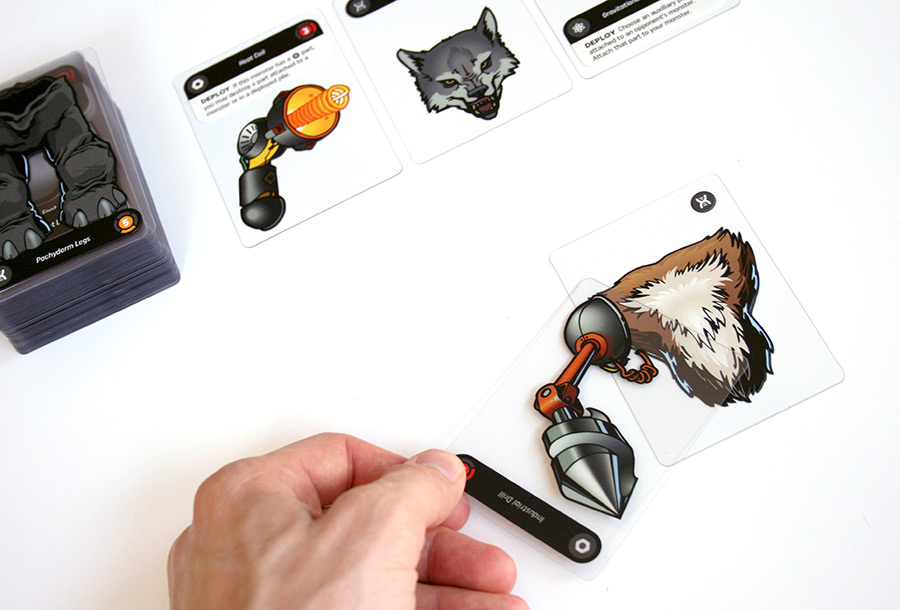
XYbrid began as a simple idea to create a strategy game where players would act as mad scientists, building monsters by assembling parts. Each card would be one part, and parts could be combined in countless ways to create unique, grotesque monsters. I think the idea grew from my love of modular creativity as a child—besides tabletop games, I was a Lego kid, and my NES franchise of choice was Mega Man. The idea of a basic system that can be customized to my own desires has always been appealing to me.
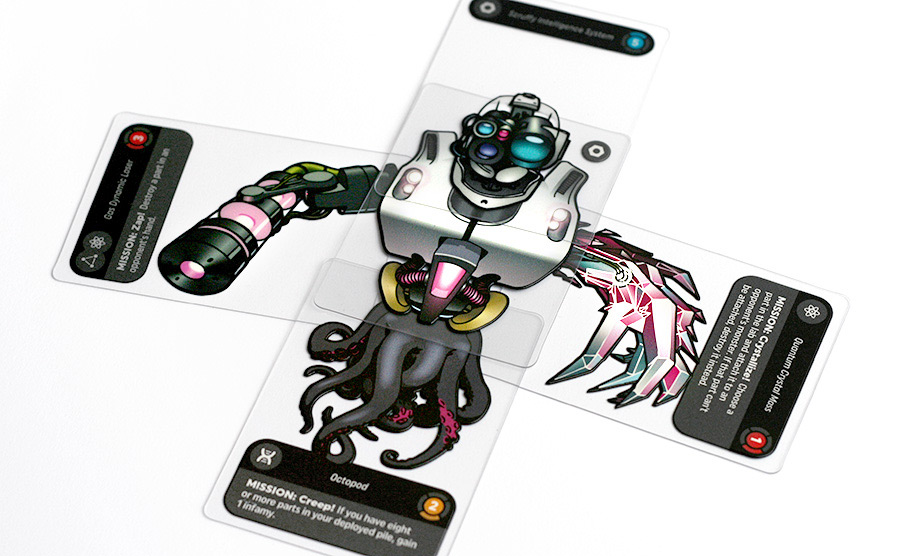
For the first year of XYbrid’s development, I worked with traditional paper cards and tested the game concept using various resource management mechanisms. While working through some playtest feedback, I realized a bigger issue with the game—it just didn’t feel like you were creating a monster. You were collecting cards and imagining a monster, but what players saw in front of them was a disjointed hodgepodge. I wanted players to feel creative, and enjoy the act of creating.
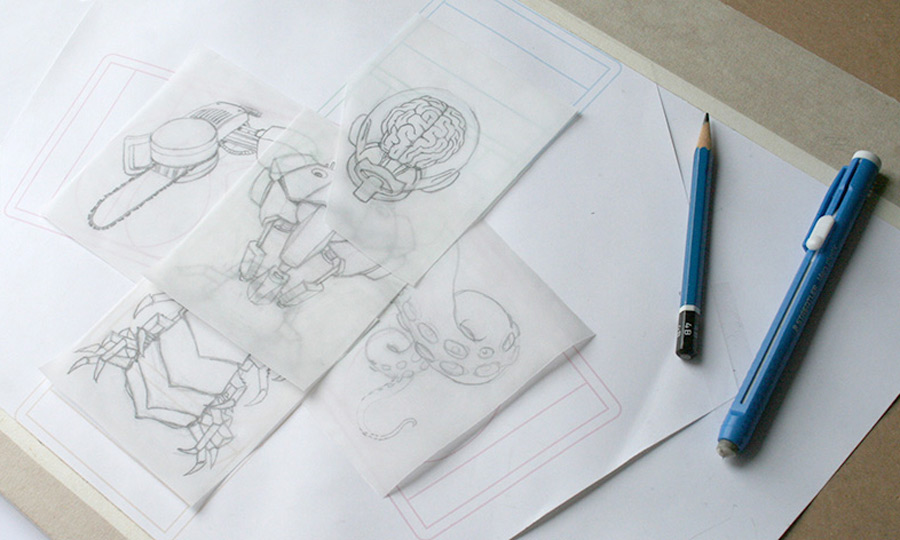
I realized the heart of the issue was that paper cards couldn’t allow monster parts to feel truly connected. With cards placed edge-to-edge, monsters felt rigid, uncomfortably stretched or squished, and unnatural (I mean, even more unnatural than intended).
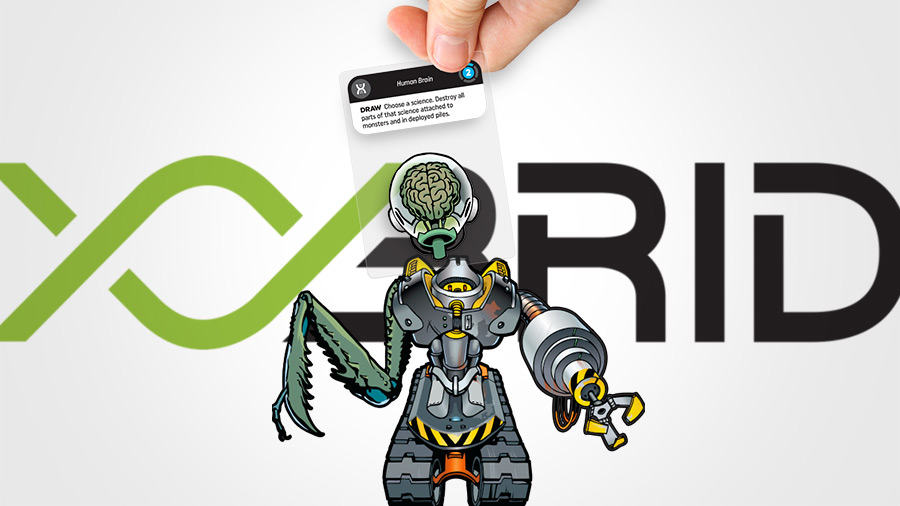
The idea to use transparent cards was a major turning point in the development of XYbrid. I knew right away that the game would have a unique aesthetic, and creating monsters would feel much more realistic than with paper cards. And, each side of the card could have different art, which has a mechanical bonus for gameplay (right arms can be flipped over to become left arms, and vice versa) and more importantly, an self-expressive bonus for players (I can choose the art I like most by flipping the card over).
This commitment to creating a visual game put XYbrid in a bit of a weird space. Its most compelling feature wasn’t quite mechanical or thematic—it was experiential. The act of choosing a card that you like, and making it part of your own monster and attaching it in a visual way was, for a certain type of player, a very compelling prospect. Playtesting repeatedly affirmed there was a niche of players wanting to have experiential fun with light strategy built in.
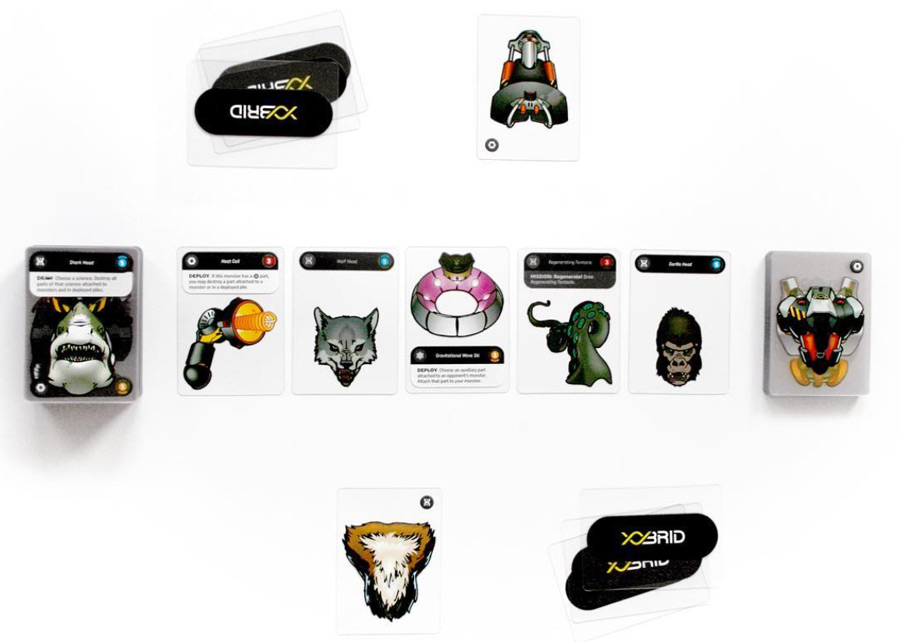
However, transparent cards brought some difficult challenges as well. The most obvious of which: there is no way to conceal information from opponents. This had some major mechanical consequences and required a new way of thinking to reinstate drama, fun, and strategy.
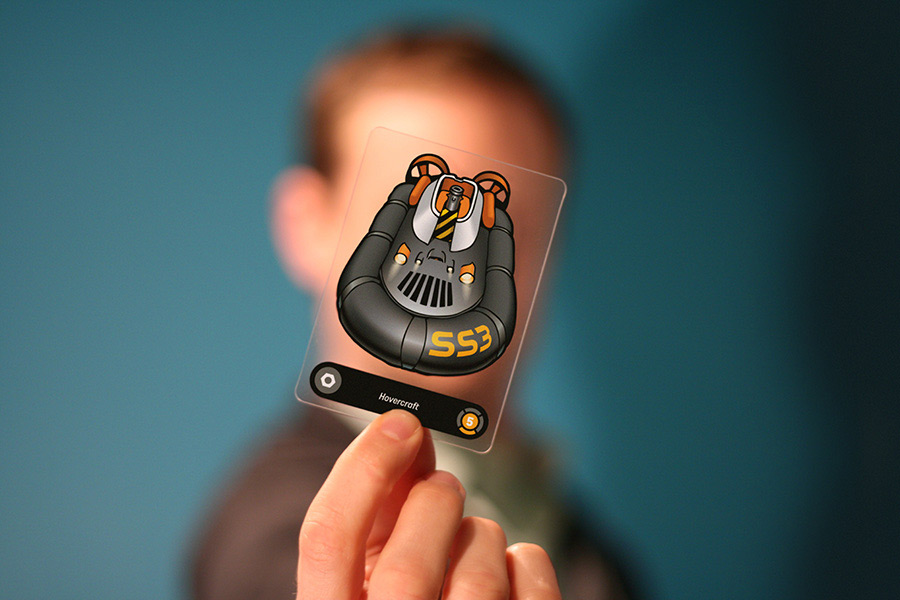
I looked to one of my favorite game modes that is based on public information—the Rochester draft format of Magic: the Gathering. I love the subtle give-and-take in trying to interpret your opponents’ moves when each player’s choices are known to everyone. Do I draft to help my own cause or deny theirs?
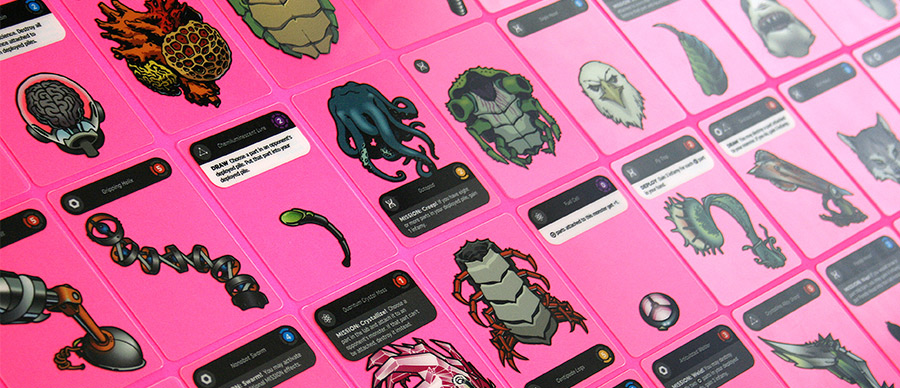
So, XYbrid was rebuilt entirely on this public draft concept, with double-sided transparent cards as parts. Unique effects were crafted to add dramatic moments throughout the game, and help players find combinations and play styles.
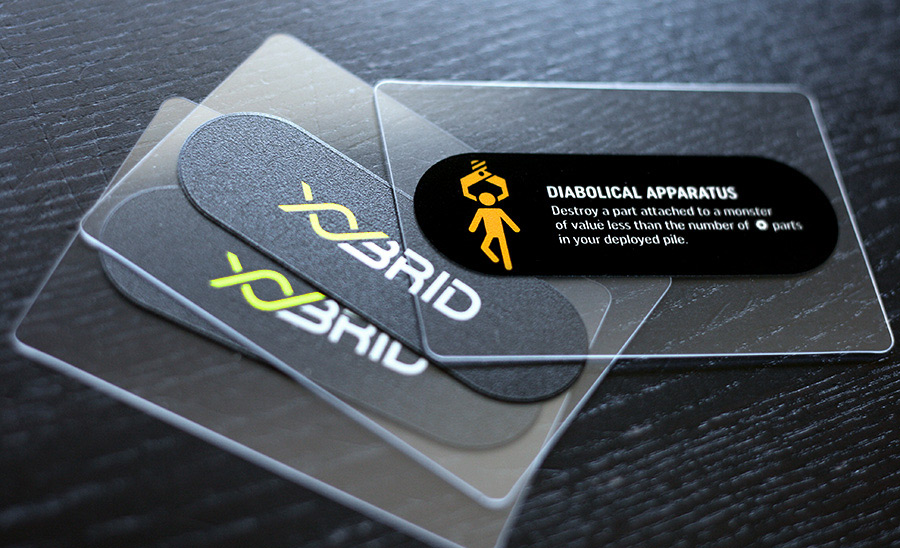
The final addition to XYbrid was Breakthrough cards. After many playtests, it was apparent that some element of true secrecy and surprise was critical to keeping the game light and fun. Breakthrough cards allowed players to use secret information to form strategies and always gave hope to players who were behind that they could catch up.
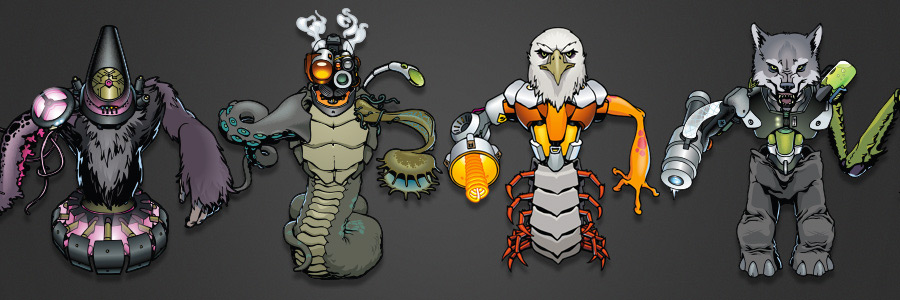
XYbrid’s art style was inspired by comic book illustrators such as Jamie Hewlett and Mike Mignola. Heavy black outlines and bright colors made the connection of parts feel seamless and exciting. All 96 parts were drawn over a basic template, to maintain a consistent perspective and scale, then inked, digitally colored and reduced to fit on a card. The information design on the cards is intentionally minimal and flat, keeping the focus on the art.
XYbrid is live on Kickstarter through April 20, 2017.
You can learn to play with this video.
Did you like this story? Please share or comment. Go to this page to submit a story yourself. Subscribe to our online magazine here!
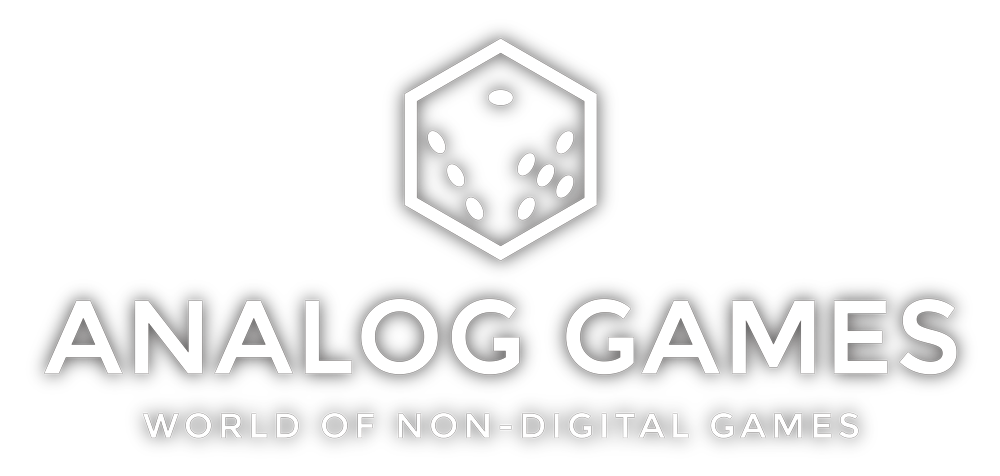
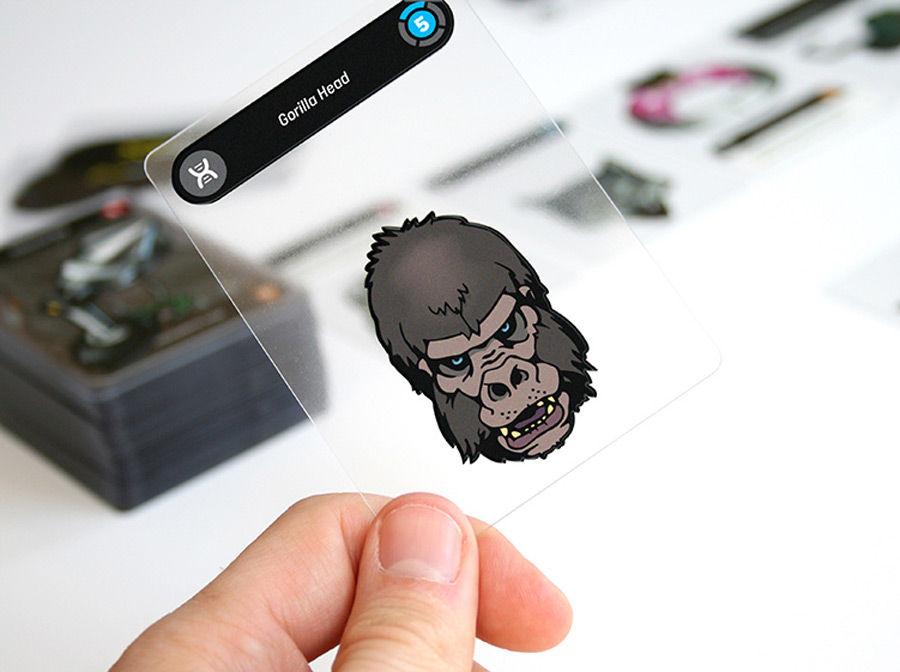
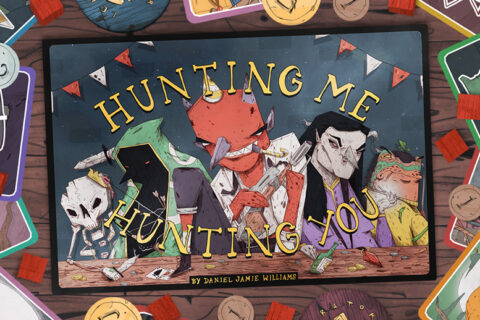
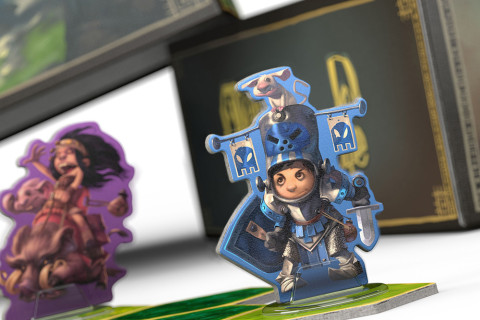
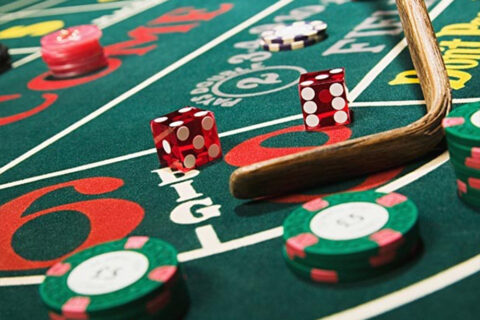
thnks for sharngs this information.
thnks for sharing.https://cheapessayswritingservice.com/custom-dissertation-writing-service/
A monster-building transparent card game, where you can play as your own monster or someone else’s. Must you follow here concrete driveway west auckland and get more tips about materials of building. You’ll love this game because it is so different from other card games. If you want a game where you can build your own dragons and trolls, then this is just what you need.
Monster-building games are a huge hit, whether you play with them or watch someone else use them. Monster-building games tend to be pretty challenging at first. I prefer to check this indoor spray foam and get more new skills about spray foam company. You have to build cards from scratch, trying to make the monster your opponent does not have and outsmart him/her in doing so – but in all honesty, this is just a small part of it.
에볼루션게임 먹튀검증 안전노리터 go
It’s a game. Five dollars is free. Try it It’s not an easy game
->-> 토토사이트
Mr. Trump posted the video to Truth Social early Friday afternoon with a line that said it was filmed on Long Island on T영주출장hursday, when Mr. Trump attended the wake of a slain New York City police officer in Massapequa Park, N.Y. The video shows two moving
Gunsbet Casino offers an exhilarating gaming experience with its wide range of slot games, table games, and live casino options. With a sleek and user-friendly interface, navigating the site is easy and enjoyable. The casino also boasts exciting promotions and bonuses, including a generous welcome package for new players. What sets Gunsbet apart is its unique Wild West theme, which adds an extra layer of fun to the gaming experience. Plus, with reliable payment methods and responsive customer support, players can feel confident and supported every step of the way. Join Gunsbet today for an unforgettable online casino adventure https://gunsbet.casinologinaustralia.com!
It’s a game. Five dollars is free. Try it It’s not an easy game
->-> 카지노사이트
It’s a game. Five dollars is free. Try it It’s not an easy game
->-> 카지노사이트 .COM
علاج دوالي الساقين
علاج دوالي الساقين يتضمن مجموعة من الخيارات التي تهدف إلى تخفيف الأعراض، تحسين المظهر، ومنع تطور الحالة. تبدأ العلاجات عادةً بأساليب غير جراحية مثل ارتداء الجوارب الضاغطة التي تساعد على تحسين تدفق الدم وتقليل التورم. بالإضافة إلى ذلك، يُنصح المرضى بتغيير نمط الحياة من خلال ممارسة التمارين الرياضية بانتظام، الحفاظ على وزن صحي، وتجنب الوقوف أو الجلوس لفترات طويلة.
This card is quite special
Spinline Casino provides an easy and secure login process for players who want to access their favorite games quickly. Whether you’re a returning user or signing in for the first time, the platform ensures a smooth experience, allowing you to get straight to the fun. The login interface is simple and intuitive, making it easy for both new and experienced users to navigate. Security is a top priority, with advanced encryption used to protect your personal information during the login process.
Once logged in, players can explore a wide range of games and promotions, all tailored to offer a unique gaming experience. Spinline Casino ensures that players have access to their accounts from multiple devices, making it convenient whether you’re at home or on the go. The platform also offers customer support to assist with any login issues or questions, ensuring that you can enjoy a hassle-free experience.
Here – Spinline login
Your article helped me a lot, is there any more related content? Thanks! https://www.binance.com/ES_la/register?ref=T7KCZASX
I don’t think the title of your article matches the content lol. Just kidding, mainly because I had some doubts after reading the article.
Your article helped me a lot, is there any more related content? Thanks! https://www.binance.com/es-MX/register?ref=JHQQKNKN
I don’t think the title of your article matches the content lol. Just kidding, mainly because I had some doubts after reading the article. https://www.binance.com/hu/register?ref=FIHEGIZ8
appanail scam: appanail scam
arctic blast scam: arctic blast scam
venoplus 8 scam: venoplus 8 scam
arctic blast scam: arctic blast scam
arctic blast scam: arctic blast scam
Java Burn scam: Java Burn scam
PrimeBiome scam: PrimeBiome scam
Pineal Guardian scam: Pineal Guardian scam
Nagano Tonic scam: Nagano Tonic scam
Java Burn scam: Java Burn scam
Mitolyn scam: Mitolyn scam
I don’t think the title of your article matches the content lol. Just kidding, mainly because I had some doubts after reading the article.
Can you be more specific about the content of your article? After reading it, I still have some doubts. Hope you can help me.
Thank you, your article surprised me, there is such an excellent point of view. Thank you for sharing, I learned a lot.
Your article helped me a lot, is there any more related content? Thanks!